Jike Zhong
MedVista3D: Vision-Language Modeling for Reducing Diagnostic Errors in 3D CT Disease Detection, Understanding and Reporting
Sep 04, 2025Abstract:Radiologic diagnostic errors-under-reading errors, inattentional blindness, and communication failures-remain prevalent in clinical practice. These issues often stem from missed localized abnormalities, limited global context, and variability in report language. These challenges are amplified in 3D imaging, where clinicians must examine hundreds of slices per scan. Addressing them requires systems with precise localized detection, global volume-level reasoning, and semantically consistent natural language reporting. However, existing 3D vision-language models are unable to meet all three needs jointly, lacking local-global understanding for spatial reasoning and struggling with the variability and noise of uncurated radiology reports. We present MedVista3D, a multi-scale semantic-enriched vision-language pretraining framework for 3D CT analysis. To enable joint disease detection and holistic interpretation, MedVista3D performs local and global image-text alignment for fine-grained representation learning within full-volume context. To address report variability, we apply language model rewrites and introduce a Radiology Semantic Matching Bank for semantics-aware alignment. MedVista3D achieves state-of-the-art performance on zero-shot disease classification, report retrieval, and medical visual question answering, while transferring well to organ segmentation and prognosis prediction. Code and datasets will be released.
Patient-Specific Autoregressive Models for Organ Motion Prediction in Radiotherapy
May 17, 2025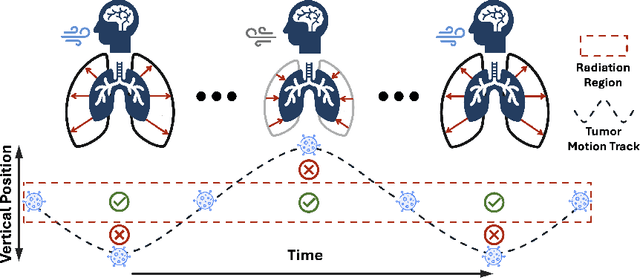
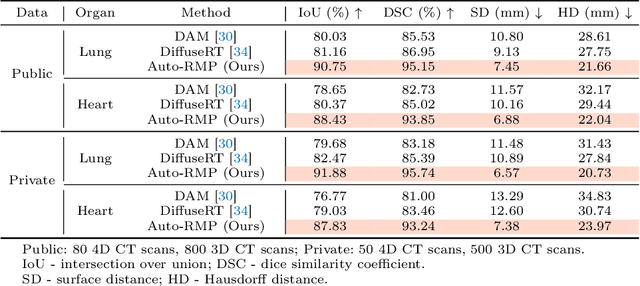
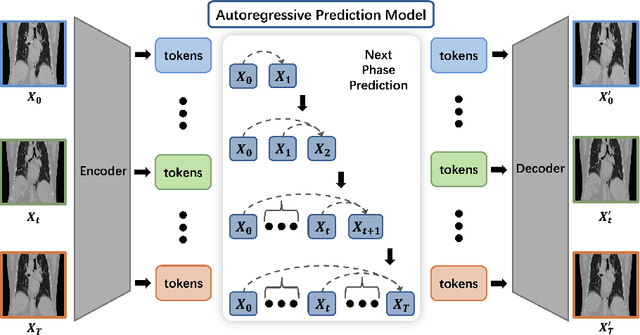

Abstract:Radiotherapy often involves a prolonged treatment period. During this time, patients may experience organ motion due to breathing and other physiological factors. Predicting and modeling this motion before treatment is crucial for ensuring precise radiation delivery. However, existing pre-treatment organ motion prediction methods primarily rely on deformation analysis using principal component analysis (PCA), which is highly dependent on registration quality and struggles to capture periodic temporal dynamics for motion modeling.In this paper, we observe that organ motion prediction closely resembles an autoregressive process, a technique widely used in natural language processing (NLP). Autoregressive models predict the next token based on previous inputs, naturally aligning with our objective of predicting future organ motion phases. Building on this insight, we reformulate organ motion prediction as an autoregressive process to better capture patient-specific motion patterns. Specifically, we acquire 4D CT scans for each patient before treatment, with each sequence comprising multiple 3D CT phases. These phases are fed into the autoregressive model to predict future phases based on prior phase motion patterns. We evaluate our method on a real-world test set of 4D CT scans from 50 patients who underwent radiotherapy at our institution and a public dataset containing 4D CT scans from 20 patients (some with multiple scans), totaling over 1,300 3D CT phases. The performance in predicting the motion of the lung and heart surpasses existing benchmarks, demonstrating its effectiveness in capturing motion dynamics from CT images. These results highlight the potential of our method to improve pre-treatment planning in radiotherapy, enabling more precise and adaptive radiation delivery.
CLS-RL: Image Classification with Rule-Based Reinforcement Learning
Mar 20, 2025



Abstract:Classification is a core task in machine learning. Recent research has shown that although Multimodal Large Language Models (MLLMs) are initially poor at image classification, fine-tuning them with an adequate amount of data can significantly enhance their performance, making them comparable to SOTA classification models. However, acquiring large-scale labeled data is expensive. In this paper, we explore few-shot MLLM classification fine-tuning. We found that SFT can cause severe overfitting issues and may even degrade performance over the zero-shot approach. To address this challenge, inspired by the recent successes in rule-based reinforcement learning, we propose CLS-RL, which uses verifiable signals as reward to fine-tune MLLMs. We discovered that CLS-RL outperforms SFT in most datasets and has a much higher average accuracy on both base-to-new and few-shot learning setting. Moreover, we observed a free-lunch phenomenon for CLS-RL; when models are fine-tuned on a particular dataset, their performance on other distinct datasets may also improve over zero-shot models, even if those datasets differ in distribution and class names. This suggests that RL-based methods effectively teach models the fundamentals of classification. Lastly, inspired by recent works in inference time thinking, we re-examine the `thinking process' during fine-tuning, a critical aspect of RL-based methods, in the context of visual classification. We question whether such tasks require extensive thinking process during fine-tuning, proposing that this may actually detract from performance. Based on this premise, we introduce the No-Thinking-CLS-RL method, which minimizes thinking processes during training by setting an equality accuracy reward. Our findings indicate that, with much less fine-tuning time, No-Thinking-CLS-RL method achieves superior in-domain performance and generalization capabilities than CLS-RL.
Med-R1: Reinforcement Learning for Generalizable Medical Reasoning in Vision-Language Models
Mar 19, 2025



Abstract:Vision-language models (VLMs) have advanced reasoning in natural scenes, but their role in medical imaging remains underexplored. Medical reasoning tasks demand robust image analysis and well-justified answers, posing challenges due to the complexity of medical images. Transparency and trustworthiness are essential for clinical adoption and regulatory compliance. We introduce Med-R1, a framework exploring reinforcement learning (RL) to enhance VLMs' generalizability and trustworthiness in medical reasoning. Leveraging the DeepSeek strategy, we employ Group Relative Policy Optimization (GRPO) to guide reasoning paths via reward signals. Unlike supervised fine-tuning (SFT), which often overfits and lacks generalization, RL fosters robust and diverse reasoning. Med-R1 is evaluated across eight medical imaging modalities: CT, MRI, Ultrasound, Dermoscopy, Fundus Photography, Optical Coherence Tomography (OCT), Microscopy, and X-ray Imaging. Compared to its base model, Qwen2-VL-2B, Med-R1 achieves a 29.94% accuracy improvement and outperforms Qwen2-VL-72B, which has 36 times more parameters. Testing across five question types-modality recognition, anatomy identification, disease diagnosis, lesion grading, and biological attribute analysis Med-R1 demonstrates superior generalization, exceeding Qwen2-VL-2B by 32.06% and surpassing Qwen2-VL-72B in question-type generalization. These findings show that RL improves medical reasoning and enables parameter-efficient models to outperform significantly larger ones. With interpretable reasoning outputs, Med-R1 represents a promising step toward generalizable, trustworthy, and clinically viable medical VLMs.
EEE-Bench: A Comprehensive Multimodal Electrical And Electronics Engineering Benchmark
Nov 03, 2024Abstract:Recent studies on large language models (LLMs) and large multimodal models (LMMs) have demonstrated promising skills in various domains including science and mathematics. However, their capability in more challenging and real-world related scenarios like engineering has not been systematically studied. To bridge this gap, we propose EEE-Bench, a multimodal benchmark aimed at assessing LMMs' capabilities in solving practical engineering tasks, using electrical and electronics engineering (EEE) as the testbed. Our benchmark consists of 2860 carefully curated problems spanning 10 essential subdomains such as analog circuits, control systems, etc. Compared to benchmarks in other domains, engineering problems are intrinsically 1) more visually complex and versatile and 2) less deterministic in solutions. Successful solutions to these problems often demand more-than-usual rigorous integration of visual and textual information as models need to understand intricate images like abstract circuits and system diagrams while taking professional instructions, making them excellent candidates for LMM evaluations. Alongside EEE-Bench, we provide extensive quantitative evaluations and fine-grained analysis of 17 widely-used open and closed-sourced LLMs and LMMs. Our results demonstrate notable deficiencies of current foundation models in EEE, with an average performance ranging from 19.48% to 46.78%. Finally, we reveal and explore a critical shortcoming in LMMs which we term laziness: the tendency to take shortcuts by relying on the text while overlooking the visual context when reasoning for technical image problems. In summary, we believe EEE-Bench not only reveals some noteworthy limitations of LMMs but also provides a valuable resource for advancing research on their application in practical engineering tasks, driving future improvements in their capability to handle complex, real-world scenarios.
Vision-Language Model Fine-Tuning via Simple Parameter-Efficient Modification
Sep 25, 2024Abstract:Recent advances in fine-tuning Vision-Language Models (VLMs) have witnessed the success of prompt tuning and adapter tuning, while the classic model fine-tuning on inherent parameters seems to be overlooked. It is believed that fine-tuning the parameters of VLMs with few-shot samples corrupts the pre-trained knowledge since fine-tuning the CLIP model even degrades performance. In this paper, we revisit this viewpoint, and propose a new perspective: fine-tuning the specific parameters instead of all will uncover the power of classic model fine-tuning on VLMs. Through our meticulous study, we propose ClipFit, a simple yet effective method to fine-tune CLIP without introducing any overhead of extra parameters. We demonstrate that by only fine-tuning the specific bias terms and normalization layers, ClipFit can improve the performance of zero-shot CLIP by 7.27\% average harmonic mean accuracy. Lastly, to understand how fine-tuning in CLIPFit affects the pre-trained models, we conducted extensive experimental analyses w.r.t. changes in internal parameters and representations. We found that low-level text bias layers and the first layer normalization layer change much more than other layers. The code is available at \url{https://github.com/minglllli/CLIPFit}.
Holistic Transfer: Towards Non-Disruptive Fine-Tuning with Partial Target Data
Nov 02, 2023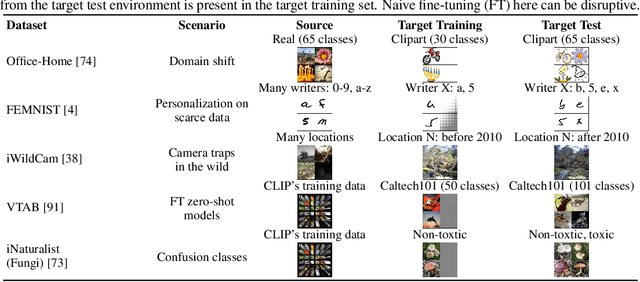
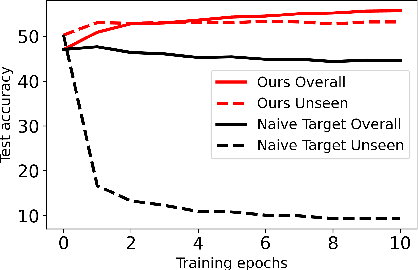
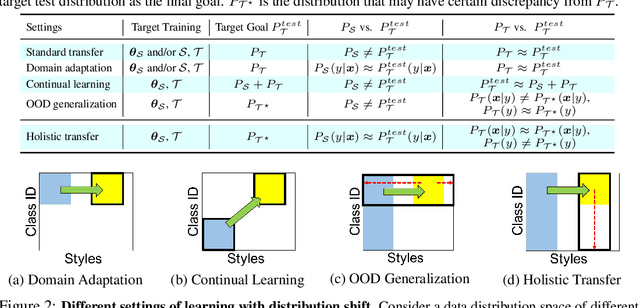
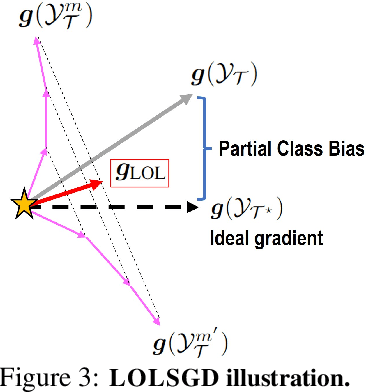
Abstract:We propose a learning problem involving adapting a pre-trained source model to the target domain for classifying all classes that appeared in the source data, using target data that covers only a partial label space. This problem is practical, as it is unrealistic for the target end-users to collect data for all classes prior to adaptation. However, it has received limited attention in the literature. To shed light on this issue, we construct benchmark datasets and conduct extensive experiments to uncover the inherent challenges. We found a dilemma -- on the one hand, adapting to the new target domain is important to claim better performance; on the other hand, we observe that preserving the classification accuracy of classes missing in the target adaptation data is highly challenging, let alone improving them. To tackle this, we identify two key directions: 1) disentangling domain gradients from classification gradients, and 2) preserving class relationships. We present several effective solutions that maintain the accuracy of the missing classes and enhance the overall performance, establishing solid baselines for holistic transfer of pre-trained models with partial target data.
Federated Learning of Shareable Bases for Personalization-Friendly Image Classification
Apr 16, 2023Abstract:Personalized federated learning (PFL) aims to harness the collective wisdom of clients' data to build customized models tailored to individual clients' data distributions. Existing works offer personalization primarily to clients who participate in the FL process, making it hard to encompass new clients who were absent or newly show up. In this paper, we propose FedBasis, a novel PFL framework to tackle such a deficiency. FedBasis learns a set of few, shareable ``basis'' models, which can be linearly combined to form personalized models for clients. Specifically for a new client, only a small set of combination coefficients, not the models, needs to be learned. This notion makes FedBasis more parameter-efficient, robust, and accurate compared to other competitive PFL baselines, especially in the low data regime, without increasing the inference cost. To demonstrate its applicability, we also present a more practical PFL testbed for image classification, featuring larger data discrepancies across clients in both the image and label spaces as well as more faithful training and test splits.
Making Batch Normalization Great in Federated Deep Learning
Mar 12, 2023Abstract:Batch Normalization (BN) is commonly used in modern deep neural networks (DNNs) to improve stability and speed up convergence during centralized training. In federated learning (FL) with non-IID decentralized data, previous works observed that training with BN could hinder performance due to the mismatch of the BN statistics between training and testing. Group Normalization (GN) is thus more often used in FL as an alternative to BN. However, from our empirical study across various FL settings, we see no consistent winner between BN and GN. This leads us to revisit the use of normalization layers in FL. We find that with proper treatments, BN can be highly competitive across a wide range of FL settings, and this requires no additional training or communication costs. We hope that our study could serve as a valuable reference for future practical usage and theoretical analysis in FL.
Learning with Free Object Segments for Long-Tailed Instance Segmentation
Mar 29, 2022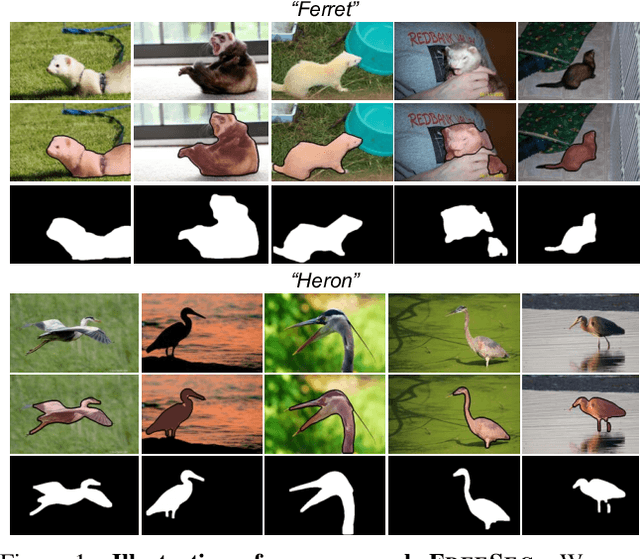

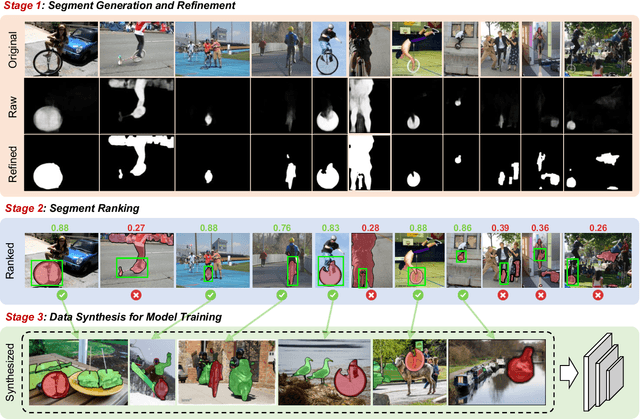
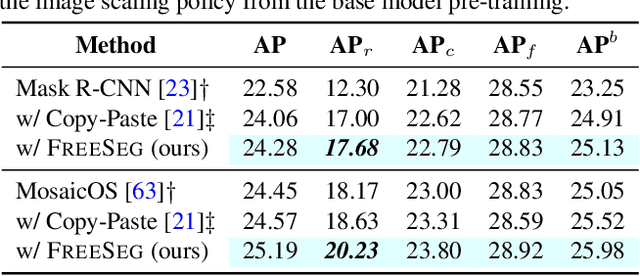
Abstract:One fundamental challenge in building an instance segmentation model for a large number of classes in complex scenes is the lack of training examples, especially for rare objects. In this paper, we explore the possibility to increase the training examples without laborious data collection and annotation. We find that an abundance of instance segments can potentially be obtained freely from object-centric images, according to two insights: (i) an object-centric image usually contains one salient object in a simple background; (ii) objects from the same class often share similar appearances or similar contrasts to the background. Motivated by these insights, we propose a simple and scalable framework FreeSeg for extracting and leveraging these "free" object foreground segments to facilitate model training in long-tailed instance segmentation. Concretely, we investigate the similarity among object-centric images of the same class to propose candidate segments of foreground instances, followed by a novel ranking of segment quality. The resulting high-quality object segments can then be used to augment the existing long-tailed datasets, e.g., by copying and pasting the segments onto the original training images. Extensive experiments show that FreeSeg yields substantial improvements on top of strong baselines and achieves state-of-the-art accuracy for segmenting rare object categories.
 Add to Chrome
Add to Chrome Add to Firefox
Add to Firefox Add to Edge
Add to Edge